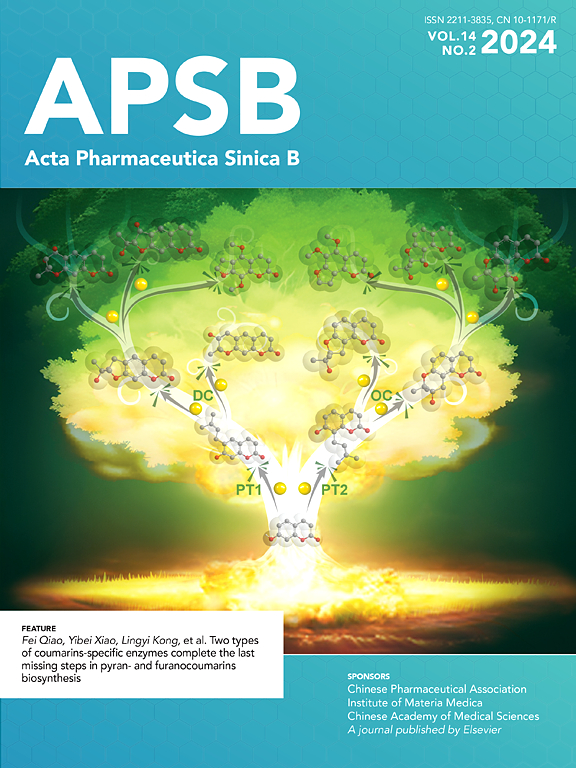两种中草药衍生激动剂揭示BRS3的不同激活模式
IF 14.6
1区 医学
Q1 PHARMACOLOGY & PHARMACY
引用次数: 0
摘要
Bombesin受体亚型-3 (BRS3)是一种孤儿G蛋白偶联受体(GPCR),在能量稳态、葡萄糖代谢和胰岛素分泌中起关键作用。最近的结构研究已经利用合成配体(包括BA1和MK-5046)阐明了BRS3信号传导机制。然而,生物活性天然化合物及其衍生物(特别是来自中药的化合物)激活BRS3的分子基础尚不清楚。在这里,我们展示了两种草药衍生化合物(DSO-5a和oriidonin)结合的人类BRS3-Gq复合物在无配体和活性状态下的高分辨率低温电子显微镜(cryo-EM)结构,分辨率分别为2.9、2.8和2.9 Å。这些结构在DSO-5a和冬凌草甲素之间显示出不同的配体识别模式。虽然这两种化合物都与正畸口袋结合,但它们参与BRS3相互作用网络的方式不同,这一点在评估钙动员和肌醇磷酸1 (IP1)积累的诱变研究中得到了证实。这些发现增强了我们对BRS3激活的理解,并为开发具有治疗潜力的小分子BRS3调节剂提供了有价值的见解。本文章由计算机程序翻译,如有差异,请以英文原文为准。

Divergent activation patterns of BRS3 revealed by two Chinese herb-derived agonists
Bombesin receptor subtype-3 (BRS3) is an orphan G protein-coupled receptor (GPCR) that plays critical roles in energy homeostasis, glucose metabolism, and insulin secretion. Recent structural studies have elucidated BRS3 signaling mechanisms using synthetic ligands, including BA1 and MK-5046. However, the molecular basis of BRS3 activation by bioactive natural compounds and their derivatives, particularly those derived from traditional Chinese medicine, remains unclear. Here, we present high-resolution cryogenic electron microscopy (cryo-EM) structures of the human BRS3–Gq complex in both unliganded and active states bound by two herb-derived compounds (DSO-5a and oridonin), at resolutions of 2.9, 2.8, and 2.9 Å, respectively. These structures display distinct ligand recognition patterns between DSO-5a and oridonin. Although both compounds bind to the orthosteric pocket, they differentially engage the interaction network of BRS3, as demonstrated by mutagenesis studies assessing calcium mobilization and inositol phosphate 1 (IP1) accumulation. These findings enhance our understanding of BRS3 activation and provide valuable insights into the development of small-molecule BRS3 modulators with therapeutic potential.
求助全文
通过发布文献求助,成功后即可免费获取论文全文。
去求助
来源期刊

Acta Pharmaceutica Sinica. B
Pharmacology, Toxicology and Pharmaceutics-General Pharmacology, Toxicology and Pharmaceutics
CiteScore
22.40
自引率
5.50%
发文量
1051
审稿时长
19 weeks
期刊介绍:
The Journal of the Institute of Materia Medica, Chinese Academy of Medical Sciences, and the Chinese Pharmaceutical Association oversees the peer review process for Acta Pharmaceutica Sinica. B (APSB).
Published monthly in English, APSB is dedicated to disseminating significant original research articles, rapid communications, and high-quality reviews that highlight recent advances across various pharmaceutical sciences domains. These encompass pharmacology, pharmaceutics, medicinal chemistry, natural products, pharmacognosy, pharmaceutical analysis, and pharmacokinetics.
A part of the Acta Pharmaceutica Sinica series, established in 1953 and indexed in prominent databases like Chemical Abstracts, Index Medicus, SciFinder Scholar, Biological Abstracts, International Pharmaceutical Abstracts, Cambridge Scientific Abstracts, and Current Bibliography on Science and Technology, APSB is sponsored by the Institute of Materia Medica, Chinese Academy of Medical Sciences, and the Chinese Pharmaceutical Association. Its production and hosting are facilitated by Elsevier B.V. This collaborative effort ensures APSB's commitment to delivering valuable contributions to the pharmaceutical sciences community.
 求助内容:
求助内容: 应助结果提醒方式:
应助结果提醒方式:


